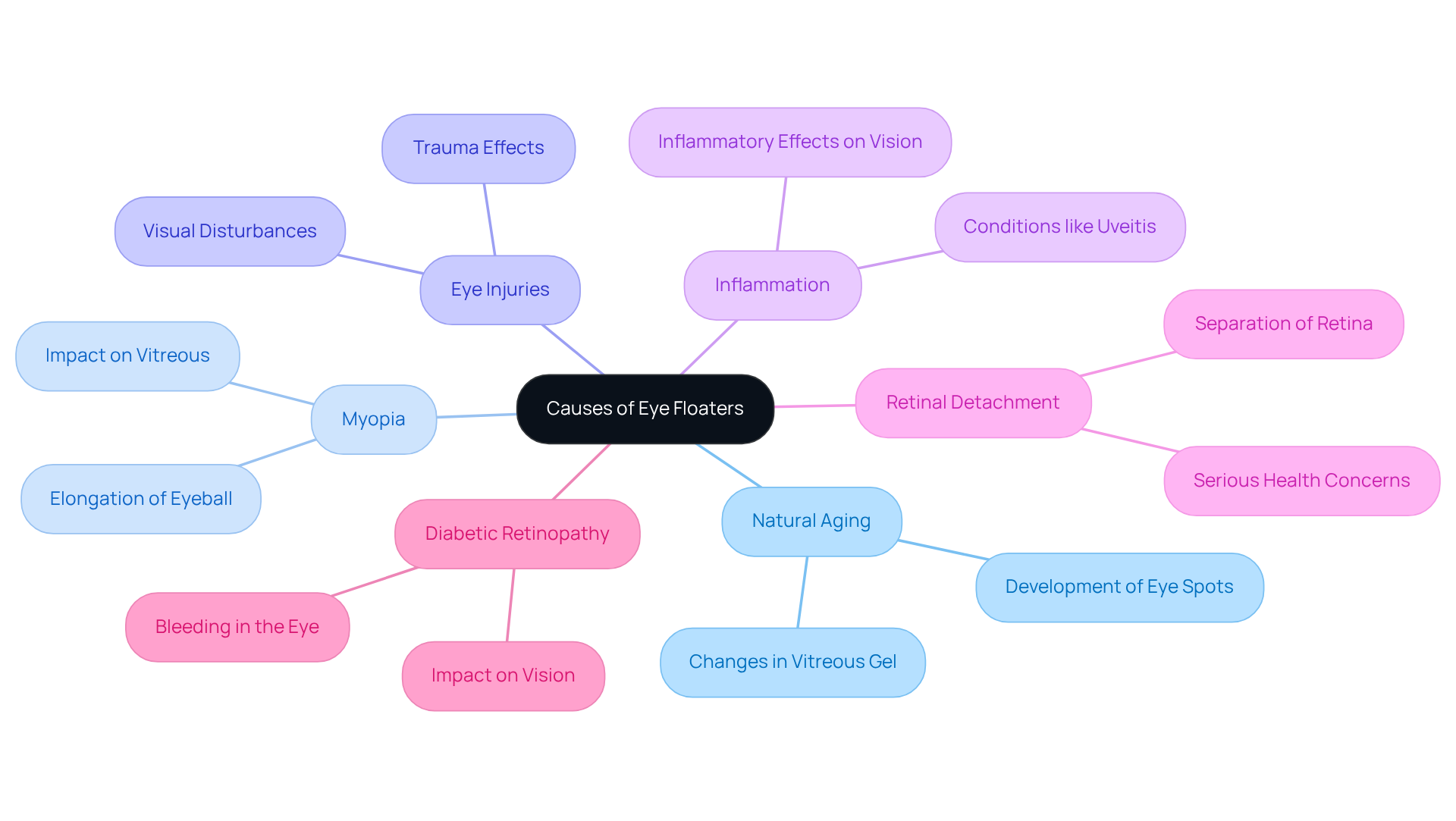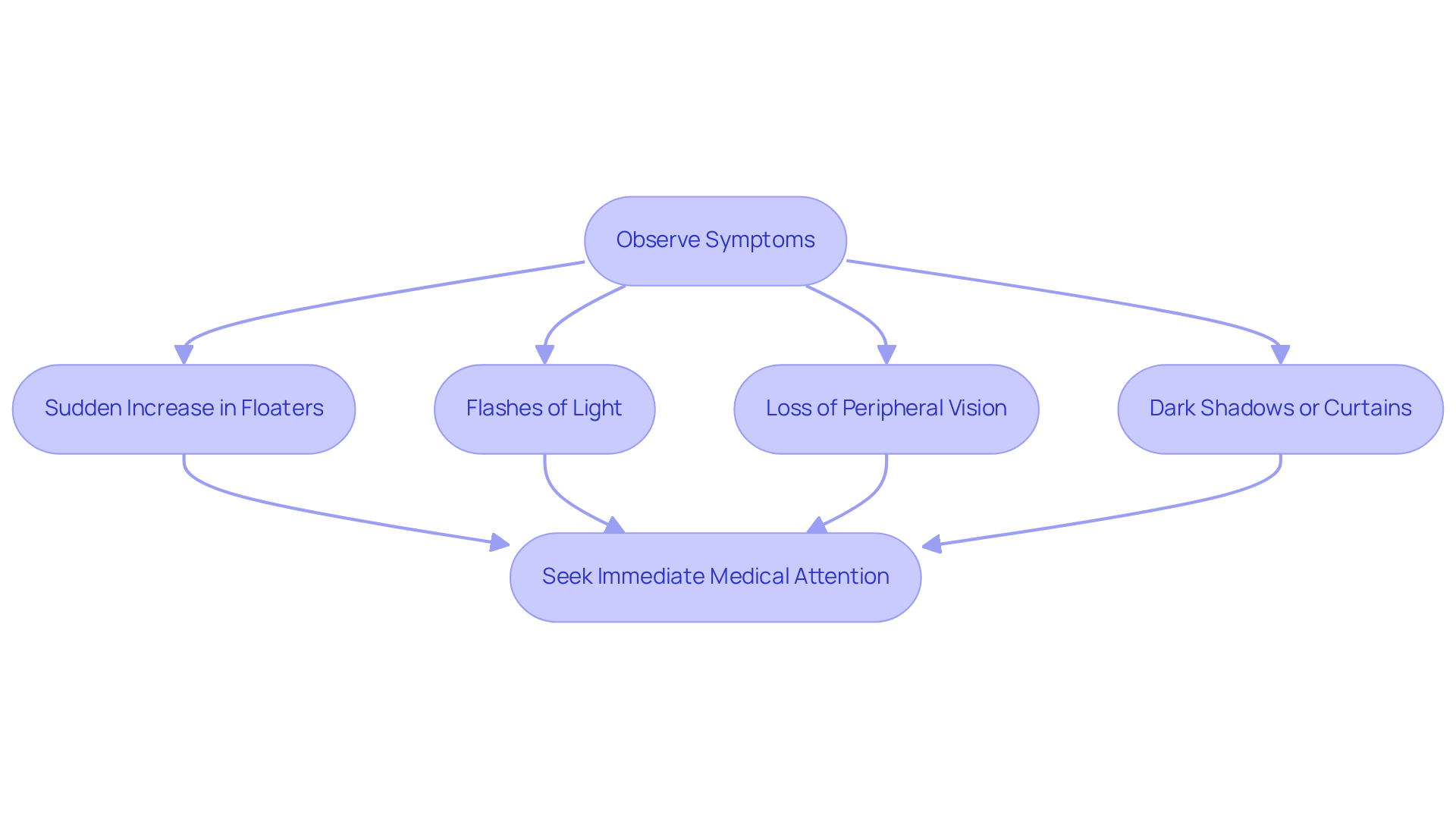Posted by: Northwest Eye in General on July 13, 2025
Overview
The causes of eye floaters can often be concerning, and it’s important to understand them. They primarily include:
- Age-related changes in the vitreous gel of the eye
- Factors such as myopia
- Eye injuries
- Inflammation
- Conditions like retinal detachment or diabetic retinopathy
We understand that learning about these causes can be overwhelming.
While most floaters are benign, we want to emphasize the importance of recognizing warning signs. A sudden increase in floaters or flashes of light can indicate potential serious health concerns. It’s common to feel anxious about these symptoms, but being aware of them is a crucial step in taking care of your eye health. Remember, we are here to help you through this process.
Introduction
Visual disturbances, often known as eye floaters, can indeed be unsettling for many individuals. We understand that these shadowy shapes, which may appear as dots or threads drifting across your vision, can raise concerns. While they are typically harmless, it’s important to recognize that they can signal underlying issues, especially as we age.
This article aims to explore the causes of eye floaters, delving into both natural aging processes and potential medical conditions that may contribute to their appearance.
What should you watch for to distinguish benign floaters from serious health concerns? Understanding these nuances is crucial for maintaining your eye health and peace of mind.
Define Eye Floaters: What They Are and How They Appear
Visual disturbances, often known as myodesopsias, can be concerning. These small, shadowy forms glide across your field of sight, appearing as dots, threads, or even cobweb-like structures. You may notice them more against bright backgrounds, such as a clear sky or a white wall. It’s important to understand that the eye floaters causes are small aggregates of gel or cells within the transparent, gel-like material that fills your eye.
As we age, the gel-like substance in our eyes can diminish and become more fluid, which is among the eye floaters causes that lead to the development of these spots. While they can be distracting, we want to reassure you that most are harmless and do not significantly interfere with your vision. Remember, it’s common to feel uneasy about changes in your sight, but you are not alone in this experience. We are here to help you navigate these feelings and provide support.

Explore Causes of Eye Floaters: From Natural Aging to Medical Conditions
As we age, it’s common to notice changes in our eyes, including the development of eye spots. These spots often result from age-related alterations in the gel-like substance of the eye. Over time, this gel can become more liquid and decrease in size, leading to the appearance of spots. However, it’s important to understand that eye floaters causes can also be influenced by other factors.
- Myopia (Nearsightedness): If you are nearsighted, you may be more prone to experiencing floaters. This is due to the , which can impact the vitreous.
- Eye Injuries: Trauma to the eye can lead to visual disturbances, which can be concerning.
- Inflammation: Conditions like uveitis can cause inflammation in the eye, resulting in similar visual disturbances.
- Retinal Detachment: Sometimes, spots may indicate a more serious issue, such as retinal detachment, where the retina separates from the back of the eye.
- Diabetic Retinopathy: This condition can result in bleeding within the eye, leading to visual disturbances.
We understand that noticing changes in your vision can be unsettling. Comprehending these factors is essential for identifying when the eye floaters causes may signify a more serious health concern. Remember, we are here to help you through this process and address any worries you may have.

Identify When Eye Floaters Signal Serious Health Concerns
While most eye spots are benign, we understand that certain symptoms may raise concerns about more . It’s important to seek immediate medical attention if you experience:
- Sudden Increase in Floaters: A rapid increase in floaters can signal a potential retinal tear or detachment.
- Flashes of Light: Accompanying flashes of light can indicate that the retina is being pulled or torn.
- Loss of Peripheral Vision: This may suggest a more serious issue, such as retinal detachment.
- Dark Shadows or Curtains: The presence of dark shadows or curtains in your line of sight can also indicate retinal detachment.
Recognizing these warning signs is crucial for preserving your vision and ensuring prompt treatment. We are here to help you through this process.

Conclusion
Understanding eye floaters is essential for anyone experiencing these common visual disturbances. We understand that these shadowy figures, often harmless, can arise from natural aging processes or various medical conditions. Recognizing the nature of eye floaters and their causes can alleviate concerns and guide you in seeking appropriate care when necessary.
This article elaborates on the different factors contributing to eye floaters, including:
- Aging
- Myopia
- Eye injuries
- Inflammation
- More serious conditions like retinal detachment and diabetic retinopathy
It’s common to feel anxious about these issues, but being aware of warning signs that may indicate a need for immediate medical attention—such as a sudden increase in floaters or flashes of light—can empower you to take action. Understanding these aspects fosters a proactive approach to your eye health.
Ultimately, staying informed about eye floaters and their potential implications is vital for maintaining vision and overall eye health. If any concerning symptoms arise, seeking professional advice can make a significant difference. Empowerment through knowledge is key—understanding eye floaters not only helps in managing them but also ensures that serious conditions are addressed promptly. We are here to help you through this process.
Frequently Asked Questions
What are eye floaters?
Eye floaters, also known as myodesopsias, are visual disturbances that appear as small, shadowy forms gliding across your field of sight. They can look like dots, threads, or cobweb-like structures.
When are eye floaters most noticeable?
Eye floaters are often more noticeable against bright backgrounds, such as a clear sky or a white wall.
What causes eye floaters?
Eye floaters are caused by small aggregates of gel or cells within the transparent, gel-like material that fills the eye. As we age, this gel-like substance can diminish and become more fluid, leading to the development of these spots.
Are eye floaters harmful?
Most eye floaters are harmless and do not significantly interfere with vision.
Should I be concerned about changes in my sight due to eye floaters?
It’s common to feel uneasy about changes in your sight, but you are not alone in this experience. Most eye floaters are normal and do not indicate a serious problem.






